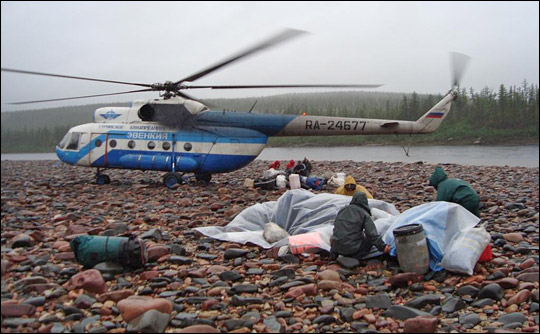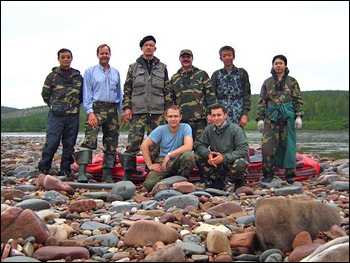

|
|
|||
Thursday, July 10From Taymyrskiy Region, Siberia 8:15 PM USZ6S (8:15 AM EDT)
The expedition team woke in Khatanga, a thriving outpost in the Taymirskiy Region of Siberia. This selo (village) of about 3,500 people is truly at the top of the world. It is the planet’s fourth most northern settlement with a population of 1,000 or more. The morning was cloudy and cool, with a steady rain. Undaunted, the team loaded their belongings into a large M-8 helicopter, squeezed themselves inside, and went looking for campsites far into the mountains, along the Kotuykan River. At a wide beach, the helicopter touched down briefly, giving them just enough time to toss their gear onto the stony shore. It departed in a swirl of sound and wind. |
|||

|
|||
|
The scientists worked hard to set up camp, inflate their boats, and settle into the wilderness. The stark beauty of the river, the forest, and the sky competed with the gentle silence to reminder them just how far away they are from the domain of humans. From Dr. RansonOur trip from the United States to Khatanga went very smoothly. There were few delays. All the bags arrived with their respective owners, on time. Our equipment got through customs without comment. Everybody met as we planned, and everyone arrived on time and healthy. Maybe things were going too well. I guess we needed a little excitement—and we got it today. Last year we’d loaded the helicopter down pretty heavily with our gear. This year we had two more people and plenty of extra gear to support them, plus we added some heavy “comfort” items, like a generator. We were pretty certain we would not be overweight, but we knew we’d have little room to spare. As we were stowing our gear aboard the helicopter, four Russians appeared. They said very little, but threw a bunch of their own gear onboard, then climbed in along side us. Somehow everyone got squeezed inside and the pilot took off. When we landed, the four hurriedly inflated a boat, grabbed their gear and took off downriver without a backwards glance. As we checked through our equipment, Slava explained that there was a custom for locals to catch rides when they could. Apparently these were Siberian “good old boys,” out for a week of fishing. As he talked, we slowly realized that we were missing a bag—a bag that contained truly vital equipment, including our GPS. We figured it must have gone downriver with the fisherman! They’d been gone for quite a little while by the time we’d made our discovery. All hands scurried to get one boat inflated. As we launched the craft onto the river, Mukhtar leapt in and sped off as quickly as the motor could take him, hoping to catch up with the fishermen. Fortunately, their boat did not have a motor, so he was able to catch the group, retrieve the wayward bag and return everything back to camp safely. It was such an odd experience. We have traveled so far and gone to such great expense to get to this truly remote area of the world. We expected to be completely alone. We certainly never expected to have locals vacationing with us! I guess it is a reminder that, no matter where you travel nor how remote the region, you are always in someone’s back yard. It is fantastic to be here. Everyone is healthy and excited to get started. We’ve set up camp on the beach next to this beautiful river. It’s just across the river from several dozen GLAS footprints, so we are perfectly situated. [One of the expedition’s objectives is to collect ground-truth data for comparing with satellite data from the Geoscience Laser Altimeter System, or GLAS]. The only hitch is that beaches in this region are stony—no sand at all. Our campsite is filled with stones ranging in size from a marble to a microwave, all mixed together. |
In steady rain, a Russian M-8 helicopter drops the scientists off on the banks of the Kotuykan River in northern Siberia. In the foreground, scientists cover gear with plastic. This is the first campsite of the expedition, and it will not be a soft one. The beach is covered with marble- to microwave-sized stones. (Photograph by Jon Ranson.) |
||

We’ve gone fishing this afternoon. We’ve caught three nice fish. It would have been four, but mine slipped away from me as I was making my way back to shore. We’ve got about three pounds of meat and our Russian friends have made a large batch of fish soup. That’s basically the entire fish cut up into chunks and put into water with some flavorings then boiled over a campfire until it is declared done. Fresh protein is hard to come by out in the Arctic wilderness, so it is a wholesome and healthy food. We came to Siberia in August last year and spent most of our days in rain. That was predictable. August, the end of the summer, is known as the rainy season. It’s difficult to make measurements in heavy rain, so we planned to come earlier, in summer, so we could enjoy drier, warmer weather. But guess what. It’s raining. Not quite a downpour, but it’s steady. And it’s cool, too. Welcome to summer! We have landed in a wonderful area for our studies. We are surrounded by forests. The trees are relatively small and far apart, but they have been extensively measured by the GLAS lidar. We know that instrument gives us fairly accurate information [about biomass] farther south, where the trees are larger. We also know that here, where the trees are small, that the measurements are fairly inaccurate. We are not sure why. So to be able to get into these forests, where we know we have difficulties, and make truly accurate measurements is a wonderful opportunity. I think this is going to be a very worthwhile expedition, with plenty of good data to bring home. |
At their first campsite, the team assembles for a group photo in front of one of the not-yet-inflated rafts. Back row from left to right: Guoqing Sun, Mukhtar Naurzbaev, Slava Kharuk, Jon Ranson, Pasha Oskorbin, and Sergei Im. Front row from left to right: Ross Nelson, and Paul Montesano. (Photograph by Jon Ranson.) |
||